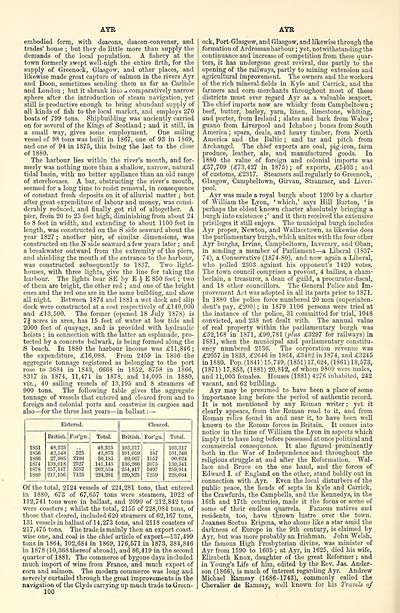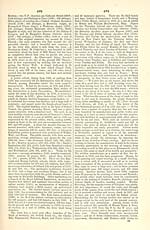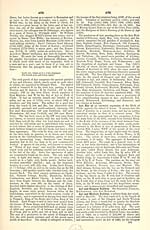Ordnance gazetteer of Scotland > Volume 1
(132) Page 100
Download files
Complete book:
Individual page:
Thumbnail gallery: Grid view | List view

AYR
embodied form, with deacons, deacon-convener, and
trades' house ; but they do little more than supply the
demands of the local population. A fishery at the
town formerly swept well-nigh the entire firth, for the
supply of Greenock, Glasgow, and other places, and
likewise made great capture of salmon in the rivers Ayr
and Doon, sometimes sending them as far as Carlisle
and London ; but it shrank into u, comparatively narrow
sphere after the introduction of steam navigation, yet
still is productive enough to bring abundant supply of
all kinds of fish to the local market, and employs 270
boats of 799 tons. Shipbuilding was anciently carried
on for several of the Kings of Scotland ; and it still, in
a small way, gives some employment. One sailing
vessel of 98 tons was built in 1867, one of 93 in 1869,
and one of 94 in 1875, this being the last to the close
of 1880.
The harbour lies within the river's mouth, and for-
merly was nothing more than a shallow, narrow, natural
tidal basin, with no better appliance than an old range
of storehouses. A bar, obstructing the river's mouth,
seemed for a long time to resist removal, in consequence
of constant fresh deposits on it of alluvial matter ; but
after great expenditure of labour and money, was consi-
derably reduced, and finally got rid of altogether. A
pier, from 20 to 25 feet high, diminishing from about 24
to 8 feet in width, and extending to about 1100 feet in
length, was constructed on the S side seaward about the
year 1827 ; another pier, of similar dimensions, was
constructed on the N side seaward a few years later ; and
a breakwater outward from the extremity of the piers,
and shielding the mouth of the entrance to the harbour,
was constructed subsequently to 1837. Two light-
houses, with three lights, give the line for taking the
harbour. The lights bear SE by E J E 850 feet ; two
of them are bright, the other red ; and one of the bright
ones and the red one are in the same building, and show
all night. Between 1874 and 1S81 a wet dock and slip
dock were constructed at a cost respectively of £140,000
and £13,500. The former (opened 18 July 1878) is
7J acres in area, has 15 feet of water at low tide and
2000 feet of quayage, and is provided with hydraulic
hoists ; in connection with the latter an esplanade, pro-
tected by a concrete bulwark, is being formed along the
S beach. In 1880 the harbour income was £11,846;
the expenditure, £16,088. From 2459 in 1836 the
aggregate tonnage registered as belonging to the port
rose to 3684 in 1843, 6668 in 1S52, 8758 in 1866,
8317 in 1874, 11,471 in 1878, and 14,095 in 1880,
viz., 40 sailing vessels of 13,195 and 8 steamers of
900 tons. The following table gives the aggregate
tonnage of vessels that entered and cleared from and to
foreign and colonial ports and coastwise in cargoes and
also — for the three last years — in ballast :—
Entered.
Cleared.
1S51
1856
1866
1874
1878
1S80
British.
For'gn.
Total.
British.
For'gn.
Total.
4S.325
42,548
27,985
138,618
257,147
217,156
325
2198
2527
5387
7125
4S,325
42,873
30,183
141,145
262,534
224,281
103,317
101,059
89,067
136,266
254,417
220.S25
1S7
1557
3075
5497
7259
103,317
101,246
90,624
139,341
259,914
22S.084
Of the total, 2124 vessels of 224,281 tons, that entered
in 1880, 673 of 67,657 tons were steamers, 1022 of
112,741 tons were in ballast, and 2090 of 212,842 tons
were coasters ; whilst the total, 2155 of 228,084 tons, of
those that cleared, included 620 steamers of 62,167 tons,
131 vessels in ballast of 14,273 tons, and 2118 coasters of
217,475 tons. The trade is mainly then an export coast-
wise one, and coal is the chief article of export — 137,499
tons in 1864, 102,684 in 1869, 176,571 in 1873, 384,S46
in 1878 (10,368 thereof abroad), and 86,419 in the second
quarter of 1881. The commerce of bygone days included
much import of wine from France, and much export of
corn and salmon. The modern commerce was long and
severely curtailed through the great improvements in the
navigation of the Clyde carrying up much trade to Green-
100
AYR
ock, Port-Glasgow, and Glasgow, and likewise through the
formation of Ardrossan harbour ; yet, notwithstanding the
continuance and increase of competition from these quar-
ters, it has undergone great revival, due partly to" the
opening of the railways, partly to mining extension and
agricultural improvement. The owners and the workers
of the rich mineral-fields in Kyle and Carrick, and the
farmers and corn-merchants throughout most of these
districts must ever regard Ayr as a valuable seaport.
The chief imports now are whisky from Campbeltown ;
beef, butter, barley, yarn, linen, limestone, whiting,
and porter, from Ireland ; slates and bark from Wales ;
guano from Liverpool and Ichaboe ; bones from South
America ; spars, deals, and heavy timber, from North
America and the Baltic ; and tar and pitch from
Archangel. The chief exports are coal, pig-iron, farm
produce, leather, ale, and manufactured goods. In
1880 the value of foreign and colonial imports was
£57,709 (£73,427 in 1875); of exports, £5403; and
of customs, £2317. Steamers sail regularly to Greenock,
Glasgow, Campbeltown, Girvan, Stranraer, and Liver-
pool.
Ayr was made a royal burgh about 1200 by a charter
of William the Lyon, 'which,' says Hill Burton, 'is
perhaps the oldest known charter absolutely bringing a
burgh into existence ; ' and it then received the extensive
privileges it still enjoys. The municipal burgh includes
Ayr proper, Newton, and Wallacetown. as likewise does
the parliamentary burgh, which unites with the four other
Ayr burghs, Irvine, Campbeltown, Inverary, and Oban,
in sending a member of Parliament — a Liberal (1837-
74), a Conservative (1874-80), and now again a Liberal,
who polled 2303 against his opponent's 1420 votes.
The town council comprises a provost, 4 bailies, a cham-
berlain, a treasurer, a dean of guild, a procurator-fiscal,
and 18 other councillors. The General Police and Im-
provement Act was adopted in all its parts prior to 1871.
In 1880 the police force numbered 20 men (superinten-
dent's pay, £200) ; in 1879 1106 persons were tried at
the instance of the police, 31 committed for trial, 1048
convicted, and 23S not dealt with. The annual value
of real property within the parliamentary burgh was
£52,168 in 1871, £90,781 (j)lus £3297 for railways) in
1881, when the municipal and parliamentary constitu-
ency numbered 2136. The corporation revenue was
£2057 in 1833, £2646 in 1864, £3482 in 1874, and £3245
in 1880. Pop. (1841) 15,749, (1851) 17,624, (1861) 18,573,
(1871) 17,853, (1881) 20,812, of whom 9809 were males,
and 11,003 females. Houses (1881) 4276 inhabited, 242
vacant, and 62 building.
Ayr may be presumed to have been a place of some
importance long before the period of authentic record.
It is not mentioned by any Roman writer ; yet it
clearly appears, from the Roman road to it, and from
Roman relics found in and near it, to have been well
known to the Roman forces in Britain. It comes into
notice in the time of William the Lyon in aspects which
imply it to have long before possessed at once political and
commercial consequence. It also figured prominently
both in the War of Independence and throughout the
religious struggle at and after the Reformation. Wal-
lace and Bruce on the one hand, and the forces of
Edward I. of England on the other, stand boldly out in
connection with Ayr. Even the local disturbers of the
public peace, the heads of septs in Kyle and Carrick,
the Crawfurds, the Campbells, and the Kennedys, in the
16th and 17th centuries, made it the focus or scene of
some of their endless quarrels. Famous natives and
residents, too, have thrown lustre over the town.
Joannes Scotus Erigena, who shone like a star amid the
darkness of Europe in the 9th century, is claimed by
Ayr, but was more probably an Irishman. John Welsh,
the famous High Presbyterian divine, was minister of
Ayr from 1590 to 1605 ; at Ayr, in 1625, died his wife,
Elizabeth Knox, daughter of the great Reformer ; and
in Young's Life of him, edited by the Rev. Jas. Ander-
son (1866), is much of interest regarding Ayr. Andrew
Michael Ramsay (1686-1743), commonly called the
Chevalier de Ramsay, well known for his Travels of
embodied form, with deacons, deacon-convener, and
trades' house ; but they do little more than supply the
demands of the local population. A fishery at the
town formerly swept well-nigh the entire firth, for the
supply of Greenock, Glasgow, and other places, and
likewise made great capture of salmon in the rivers Ayr
and Doon, sometimes sending them as far as Carlisle
and London ; but it shrank into u, comparatively narrow
sphere after the introduction of steam navigation, yet
still is productive enough to bring abundant supply of
all kinds of fish to the local market, and employs 270
boats of 799 tons. Shipbuilding was anciently carried
on for several of the Kings of Scotland ; and it still, in
a small way, gives some employment. One sailing
vessel of 98 tons was built in 1867, one of 93 in 1869,
and one of 94 in 1875, this being the last to the close
of 1880.
The harbour lies within the river's mouth, and for-
merly was nothing more than a shallow, narrow, natural
tidal basin, with no better appliance than an old range
of storehouses. A bar, obstructing the river's mouth,
seemed for a long time to resist removal, in consequence
of constant fresh deposits on it of alluvial matter ; but
after great expenditure of labour and money, was consi-
derably reduced, and finally got rid of altogether. A
pier, from 20 to 25 feet high, diminishing from about 24
to 8 feet in width, and extending to about 1100 feet in
length, was constructed on the S side seaward about the
year 1827 ; another pier, of similar dimensions, was
constructed on the N side seaward a few years later ; and
a breakwater outward from the extremity of the piers,
and shielding the mouth of the entrance to the harbour,
was constructed subsequently to 1837. Two light-
houses, with three lights, give the line for taking the
harbour. The lights bear SE by E J E 850 feet ; two
of them are bright, the other red ; and one of the bright
ones and the red one are in the same building, and show
all night. Between 1874 and 1S81 a wet dock and slip
dock were constructed at a cost respectively of £140,000
and £13,500. The former (opened 18 July 1878) is
7J acres in area, has 15 feet of water at low tide and
2000 feet of quayage, and is provided with hydraulic
hoists ; in connection with the latter an esplanade, pro-
tected by a concrete bulwark, is being formed along the
S beach. In 1880 the harbour income was £11,846;
the expenditure, £16,088. From 2459 in 1836 the
aggregate tonnage registered as belonging to the port
rose to 3684 in 1843, 6668 in 1S52, 8758 in 1866,
8317 in 1874, 11,471 in 1878, and 14,095 in 1880,
viz., 40 sailing vessels of 13,195 and 8 steamers of
900 tons. The following table gives the aggregate
tonnage of vessels that entered and cleared from and to
foreign and colonial ports and coastwise in cargoes and
also — for the three last years — in ballast :—
Entered.
Cleared.
1S51
1856
1866
1874
1878
1S80
British.
For'gn.
Total.
British.
For'gn.
Total.
4S.325
42,548
27,985
138,618
257,147
217,156
325
2198
2527
5387
7125
4S,325
42,873
30,183
141,145
262,534
224,281
103,317
101,059
89,067
136,266
254,417
220.S25
1S7
1557
3075
5497
7259
103,317
101,246
90,624
139,341
259,914
22S.084
Of the total, 2124 vessels of 224,281 tons, that entered
in 1880, 673 of 67,657 tons were steamers, 1022 of
112,741 tons were in ballast, and 2090 of 212,842 tons
were coasters ; whilst the total, 2155 of 228,084 tons, of
those that cleared, included 620 steamers of 62,167 tons,
131 vessels in ballast of 14,273 tons, and 2118 coasters of
217,475 tons. The trade is mainly then an export coast-
wise one, and coal is the chief article of export — 137,499
tons in 1864, 102,684 in 1869, 176,571 in 1873, 384,S46
in 1878 (10,368 thereof abroad), and 86,419 in the second
quarter of 1881. The commerce of bygone days included
much import of wine from France, and much export of
corn and salmon. The modern commerce was long and
severely curtailed through the great improvements in the
navigation of the Clyde carrying up much trade to Green-
100
AYR
ock, Port-Glasgow, and Glasgow, and likewise through the
formation of Ardrossan harbour ; yet, notwithstanding the
continuance and increase of competition from these quar-
ters, it has undergone great revival, due partly to" the
opening of the railways, partly to mining extension and
agricultural improvement. The owners and the workers
of the rich mineral-fields in Kyle and Carrick, and the
farmers and corn-merchants throughout most of these
districts must ever regard Ayr as a valuable seaport.
The chief imports now are whisky from Campbeltown ;
beef, butter, barley, yarn, linen, limestone, whiting,
and porter, from Ireland ; slates and bark from Wales ;
guano from Liverpool and Ichaboe ; bones from South
America ; spars, deals, and heavy timber, from North
America and the Baltic ; and tar and pitch from
Archangel. The chief exports are coal, pig-iron, farm
produce, leather, ale, and manufactured goods. In
1880 the value of foreign and colonial imports was
£57,709 (£73,427 in 1875); of exports, £5403; and
of customs, £2317. Steamers sail regularly to Greenock,
Glasgow, Campbeltown, Girvan, Stranraer, and Liver-
pool.
Ayr was made a royal burgh about 1200 by a charter
of William the Lyon, 'which,' says Hill Burton, 'is
perhaps the oldest known charter absolutely bringing a
burgh into existence ; ' and it then received the extensive
privileges it still enjoys. The municipal burgh includes
Ayr proper, Newton, and Wallacetown. as likewise does
the parliamentary burgh, which unites with the four other
Ayr burghs, Irvine, Campbeltown, Inverary, and Oban,
in sending a member of Parliament — a Liberal (1837-
74), a Conservative (1874-80), and now again a Liberal,
who polled 2303 against his opponent's 1420 votes.
The town council comprises a provost, 4 bailies, a cham-
berlain, a treasurer, a dean of guild, a procurator-fiscal,
and 18 other councillors. The General Police and Im-
provement Act was adopted in all its parts prior to 1871.
In 1880 the police force numbered 20 men (superinten-
dent's pay, £200) ; in 1879 1106 persons were tried at
the instance of the police, 31 committed for trial, 1048
convicted, and 23S not dealt with. The annual value
of real property within the parliamentary burgh was
£52,168 in 1871, £90,781 (j)lus £3297 for railways) in
1881, when the municipal and parliamentary constitu-
ency numbered 2136. The corporation revenue was
£2057 in 1833, £2646 in 1864, £3482 in 1874, and £3245
in 1880. Pop. (1841) 15,749, (1851) 17,624, (1861) 18,573,
(1871) 17,853, (1881) 20,812, of whom 9809 were males,
and 11,003 females. Houses (1881) 4276 inhabited, 242
vacant, and 62 building.
Ayr may be presumed to have been a place of some
importance long before the period of authentic record.
It is not mentioned by any Roman writer ; yet it
clearly appears, from the Roman road to it, and from
Roman relics found in and near it, to have been well
known to the Roman forces in Britain. It comes into
notice in the time of William the Lyon in aspects which
imply it to have long before possessed at once political and
commercial consequence. It also figured prominently
both in the War of Independence and throughout the
religious struggle at and after the Reformation. Wal-
lace and Bruce on the one hand, and the forces of
Edward I. of England on the other, stand boldly out in
connection with Ayr. Even the local disturbers of the
public peace, the heads of septs in Kyle and Carrick,
the Crawfurds, the Campbells, and the Kennedys, in the
16th and 17th centuries, made it the focus or scene of
some of their endless quarrels. Famous natives and
residents, too, have thrown lustre over the town.
Joannes Scotus Erigena, who shone like a star amid the
darkness of Europe in the 9th century, is claimed by
Ayr, but was more probably an Irishman. John Welsh,
the famous High Presbyterian divine, was minister of
Ayr from 1590 to 1605 ; at Ayr, in 1625, died his wife,
Elizabeth Knox, daughter of the great Reformer ; and
in Young's Life of him, edited by the Rev. Jas. Ander-
son (1866), is much of interest regarding Ayr. Andrew
Michael Ramsay (1686-1743), commonly called the
Chevalier de Ramsay, well known for his Travels of
Set display mode to: Large image | Transcription
Images and transcriptions on this page, including medium image downloads, may be used under the Creative Commons Attribution 4.0 International Licence unless otherwise stated. ![]()
| Gazetteers of Scotland, 1803-1901 > Ordnance gazetteer of Scotland > Volume 1 > (132) Page 100 |
|---|
| Permanent URL | https://digital.nls.uk/97370350 |
|---|
| Attribution and copyright: |
|
|---|---|

